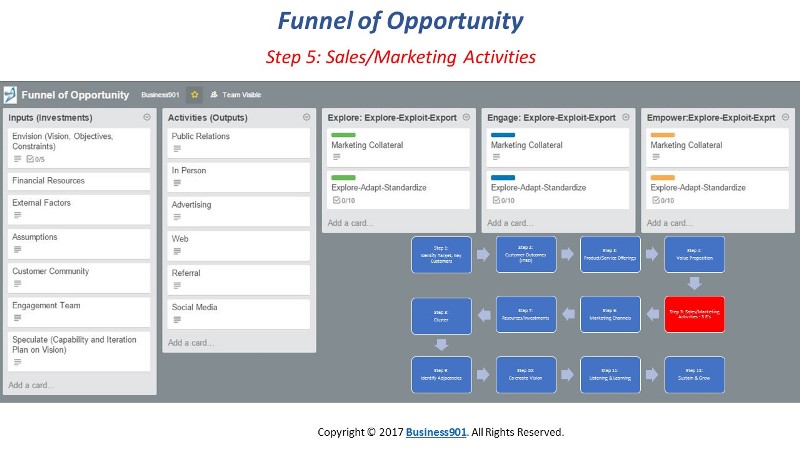Step 5: What were the Sales/Marketing activities that were used in each stage? (Think Down – Individual: Explore, Engage, Empower)
The main goal to paint a picture of each segment of the current prospect base. We start with what is known our current engaged prospects, purchase stage. Then we move to the pre-purchase stage.
The first way we approach this exercise is to walk through the scenario with a current prospect. We do this internally with the sales people involved and then have a conversation with a prospect if possible. It is also recommended to have a conversation with lost prospects. When we interview the prospect, we need to first get their thoughts then go back and solidify what we thought if they were not answered in the first set of questions. We go to their LinkedIn profile and capture the information if it is there. If not try to gather the same information from their website. We then go through the 2 stages and ask the who question. It is important to find who was involved in each stage of prospects life cycle. If they have a LinkedIn profile, we will capture their name and position and their LinkedIn contact link. If they have other information like a twitter name or email capture that also.
In each section, we will create what happen during that cycle. We probably have to interview our people interacting with them at that particular stage. Sometimes it is just easier to interview someone, and if we do that, I would like to do the first one just to go through the interview process one time. This is not meant to take a lot of time. You can cut paste most of the information and each stage we are only looking for a paragraph or two. I will leave some general notes, but they are not meant to be inclusive at this time. We are really looking at doing a single pass through to see how easy it is to capture the information. Then come back and tell me what you had trouble with and I will assist you.
Pick 5 or so of our best prospects at this time, and then 10 or so of the not so good but only gather LinkedIn information and cluster if possible. we need to do it for the entire list of names that was sent if possible. An example of how we will extend this somewhat to build a complete set of personas and even prospects is that we will also capture the list on the LinkedIn Customer Profile of “People also Viewed.” We can even scrape LinkedIn by going deeper into those names the same way. However, we do not want to do that yet.
Developing a current state/prospect is imperative. You cannot move to a vision without knowing where you are at. When we establish our current prospects, and we envision the future it is much easier to speculate what steps we need to take to get there. We look at our current practices and evaluate what we need to continue doing, what we need to stop and what we need to improve. Then we decide what we need to start new. If we don’t, we will never create a baseline or measurements to get anywhere. Or in other words, we need to find our starting point.
The Funnel of Opportunity Part 8 PDF (Important to Read): https://drive.google.com/open?id=0Bz5yH-7cFo5MOTU4RTZ0UFhock0
As you will hear me often say, you don’t find water by digging sideways, you find it by digging deeper. The next 2 -days is about digging deeper into your core customers. Once we get through this week, I hope the idea of how well you need to understand your customer base will be understood. As Dan Pink says, To Sell is Human. This effort centers around using the Vision Deployment Matrix (VDM) and the Challenger Customer ideas.
I do not encourage you to complete the VDM though in the document you can download an excel sheet. My preferred method is creating a Trello Board for the exercise which I have one created and happy to send a copy of the board with cards on it if you would like. But it is not necessary for this program.
The presentation was from a recent webinar that I did utilizing Kata (A Lean Thing) and VDM. I edited the Kata out of the attached copy. What learning I want you to take from it is the idea of who you must influence or talk to within an organization during the 3 cycles of Empower, Engage, Explore and their Level of Perspective during that time.
The mind map on the Challenger Customer does the same thing in a different way. If you would like me to explain that in a video, let me know. But the right side is traditional thinking, and the left side is current thoughts. The reason I like Dixon’s (the author of the 2 Challenger Books) work is that it is grounded in research.
Vision deployment PDF: https://drive.google.com/open?id=0Bz5yH-7cFo5MS0hVNkZjT2ZuZkU
Levels of Perspective: https://drive.google.com/open?id=0Bz5yH-7cFo5MRUNveWl2TDlONXM
Challenger Customer: https://drive.google.com/open?id=0Bz5yH-7cFo5MbXN5cy1seDQzdWs
Beginning: Funnel of Opportunity Introduction
Previous Page: Step 4: Value Proposition Next Page: Step 6: Marketing Channels



